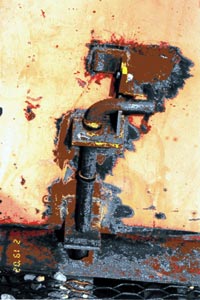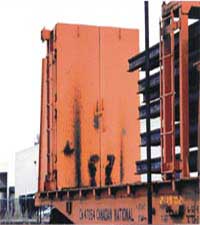Main track derailment
Canadian National
Train M-337-31-24
Mile 20.00, Bala Subdivision
Richmond Hill, Ontario
The Transportation Safety Board of Canada (TSB) investigated this occurrence for the purpose of advancing transportation safety. It is not the function of the Board to assign fault or determine civil or criminal liability. This report is not created for use in the context of legal, disciplinary or other proceedings. See Ownership and use of content. Masculine pronouns and position titles may be used to signify all genders to comply with the Canadian Transportation Accident Investigation and Safety Board Act (S.C. 1989, c. 3).
Summary
At approximately 2150 eastern standard time on 24 September 2001, Canadian National (CN) freight train M337-31-24 (train 337) travelling northward on the west main track of the Bala Subdivision in the vicinity of Mile 20.0, near Richmond Hill, Ontario passed train Q-106-41-23 (train 106) travelling southward on the east main track. While the two trains were adjacent to each other, the locomotive engineer of train 337 detected an irregularity in the manner that his train was operating and brought his train to a stop. An examination of the train revealed that 21 cars had derailed. Train 106 was unaffected by the derailment and was not stopped.
Ce rapport est également disponible en français.
Factual information
Train 337 had departed Toronto, Ontario, Mile 0.0, and was destined for Winnipeg, Manitoba. At approximately 1850Footnote 1, as the opposing train passed, the locomotive engineer of train 337 noticed that his train did not respond to a throttle command for increased speed and, suspecting a serious mechanical irregularity, brought his train to a stop. After conducting the required emergency procedures, the crew determined that 21 cars, the 40th to the 60th inclusive, had derailed. The derailed cars remained upright with only minor damage to their running gear. A large gouged and battered steel door, measuring about 1.4 metres by 3 metres and weighing approximately 450 kg, was lying on the roadbed in the vicinity of the last derailed cars at Mile 20.0. The door was one of two installed on CN 46570, the 37th car in the train. It was the trailing end and bulkhead door end car of a 34-car rail transporter consist. The west main track had been shifted about 11 inches (28 cm) to the west near where the door had fallen. The outside of the east rail displayed impact damage. Deep gouge marks were observed in the ballast between the two main tracks.
The general merchandise train, powered by two locomotives, was hauling 40 loaded cars and 20 empty cars. It was approximately 3000 feet long and weighed about 5100 tons.
In the area of Mile 20.0, the subdivision is a tangent double main track. The authorised speed is 70 miles per hour (mph) for passenger trains and 60 mph for freight trains. Train movements in this area are controlled by a Centralized Traffic Control system, which is authorised by the Canadian Rail Operating Rules and supervised by a rail traffic controller in Toronto.
Event recorder data indicated that train 337 was travelling at a speed of 28 mph at the time the locomotive engineer initiated the brake application.
After train 106 was yarded in Toronto, fresh impact damage was noted on the side of the 29th car, flat car CN 677080.
The rail transporter equipment is used for the transportation of Continuous Welded Rail (CWR) and is owned and maintained by CN. The Railway Freight Car Inspection and Safety Rules are applicable to work equipment in such service. This equipment is not interchanged with other railways.
The rail transporter cars, marshalled together in a consist of the needed length, are modified flat cars with racks up to ten tiers high mounted along the centre of the car bed. Each tier is equipped with 10 roller-equipped slots to allow the CWR to be rolled along the length of rail transporter consist for loading and unloading. Each rail transporter consist has a centrally located "anchor car" with an anchoring system on the tiers to prevent the rail from shifting.
The rail transporter consist is marshalled with a bulkhead door car at each end (see Figure 1). The doors open towards the rail and ensures containment of the rail should it shift in transit. This type of equipment is restricted to a maximum speed of 40 mph.
The door had been supported by three hinges. The hinge weld areas on the fallen door were shiny and rust free, indicating that they had been recently torn off. The door locking device consisted of two brackets welded to the door face with a pin that slides through the brackets into the car floor (see Figure 2)
The door brackets and locking pin were missing and the weldment areas for the brackets were rust covered. It was determined that a piece of piping with a small valve attached had been inserted into the car floor in front of the door as a means of securement for an undetermined period of time. This makeshift device was not recovered. The door stop, welded to the side of CN 46570 to restrict door swing, was missing and the weldment area was rust covered.
The rail transporter consist was loaded in Windsor, Ontario and was destined for Winnipeg. The employees last loading the transporter consist at Sarnia, Ontario, did not take exception to the condition of the bulkhead door and its manner of securement. In fact, it was at this location on a prior occasion that the makeshift pin had been placed on the car. The rail transporter consist travelled to the CN MacMillan Yard in Toronto where it was placed on train 337. The train received a certified car inspection (CCI) prior to departure and no defects were noted. During a CCI, the inspector focuses on car running gear and safety appliances. With the exception of the requirement that doors on box cars be in good repair (section 15 [i]) and a note that in areas where an inspector is not available to conduct a CCI, other railway employees must inspect for hazards such as a "door insecurely attached" (Appendix 1, section 1[f]), Transport Canada's Railway Freight Car Inspection and Safety Rules do not address the issue of doors.
The identification of above-deck defects (i.e. those not affecting safe movement) for cars in captive service, such as rail transporter cars, is the responsibility of employees working with this equipment. Such employees will alert their supervisor, who will in turn notify the appropriate repair facility, which, for rail transporter cars, is the CN Rail shops in Winnipeg. In the six months prior to this accident, this car had seen service in Manitoba, Saskatchewan, Quebec and Ontario, transporting scrap rail to Winnipeg and returning with new rail. The area of the missing locking pin was clearly visible and had been observed by railway employees during loading and unloading. However, there were no reports that the car was in need of repair. There was also no information to indicate that this piece of equipment was kept in service for logistical reasons, i.e. no replacement car was available.
Analysis
The manner of train operation played no role in the accident. Train 337 derailed due to track shift attributable to contact with the bulkhead door from CN 46570. The door, having become loose after the makeshift securement device had failed, swung foul of, and contacted, the adjacent train as the stop mechanism was missing. Having been torn from its securement, the bulkhead door fell between the two trains and was jammed against, and shifted, the track.
A door of this size, if swinging open on moving equipment, would pose a direct danger to any persons standing near the tracks and to head-end train crew if an occupied locomotive on an adjacent track were struck. Such a loose item could also damage passing passenger trains. This accident has also shown that such an item can derail a train. As shown from the rust in the weldment areas of the missing door components, the car movement record and information offered by railway employees, this car had posed a hazard over a wide geographic area for some time. Many employees would have had occasion to not only observe the defects but work with the jury-rigged retaining mechanism, yet this equipment remained in service with this safety defect.
Aside from bulkhead door end cars on rail transporters and box cars, the TSB knows of no other type of rail car equipped with doors that could present a danger to adjacent equipment if not properly secured. Including malfunctioning door securement for this type of car as a defect in the Railway Freight Car Inspection and Safety Rules would both ensure that such defects are inspected for, and that identified cars are required to be immediately removed from service.
Findings
Findings as to causes and contributing factors
- The derailment was initiated when the bulkhead door on CN 46570 opened, swung out and contacted the side of train 106.
Findings as to risk
- There is no effective system in place to ensure cars with such defective doors are removed from service.
Other Findings
- Inclusion of malfunctioning door securement for this type of car in the Railway Freight Car Inspection and Safety Rules would both ensure that such defects are inspected and that identified cars are required to be immediately removed from service.
Safety action taken
On the 17 January 2002, the TSB issued a Rail Safety Information Letter to Transport Canada (TC) relating the details of this accident. The letter outlined that the train consist had included a specialized car with a very large, heavy bulkhead door with a makeshift securement mechanism which had failed, allowing the door to swing out and contact an adjacent train. It was also indicated that the defective condition of the door was known to railway employees and that current rules and company policies, procedures and guidelines did not appear to cover door defects for this equipment.
TC advised that such cars are inspected by railway engineering employees in accordance with company specifications to verify that they are safe to move and that they receive a safety inspection by a certified car inspector when they are marshalled in a revenue train.
TC indicated that there is a general provision of the Railway Freight Car Inspection and Safety Rules which states, "...a railway company shall ensure the freight cars it places or continues in service are free from all safety defects described in Part II of these rules. TC indicated that, while not specifically addressing rail transporter cars, sound inspection principles based on these Rules provided for the defective condition of the subject car to be identified.
TC stated that CN has now inspected all of their rail transporter cars and completed a program to repair and modify the locking pin mechanisms. CN has also reiterated its loading and unloading inspection program for these cars with their mechanical inspectors and advised them to pay particular attention to the door locking mechanisms and doorstops.
This report concludes the Transportation Safety Board's investigation into this occurrence. Consequently, the Board authorized the release of this report on .

